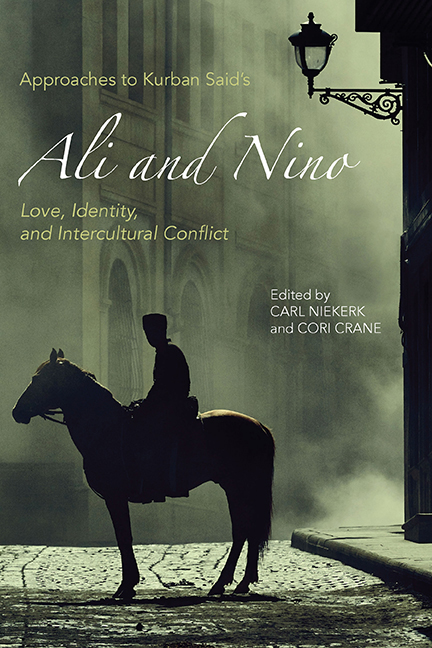Book contents
- Frontmatter
- Contents
- Acknowledgments
- Notes on Editions of and References to Ali and Nino
- Introduction: Ali and Nino as World Literature
- 1 Ali and Nino: The Novel as/of Cultural Translation
- 2 Crossing Borders, Crossing Disciplines: Ali and Nino in the Twenty-First Century
- 3 Glowing Rubies and Persian Daggers: The Role of Persian Poetry in Ali and Nino
- 4 Gendered Stereotypes and Cross-Cultural Moral Values through the Eyes of Kurban Said
- 5 Orientalist Itineraries: Cultural Hegemony, Gender, Race, and Religion in Ali and Nino
- 6 Gendered Conflicts in Muslim and Christian Cultures: Honor (and Shame) in Ali and Nino
- 7 Love and Politics: Retelling History in Ali and Nino and Artush and Zaur
- 8 “Herr Professor, Please: We'd Rather Stay in Asia”: Ali Khan Shirvanshir and the Spaces of Baku
- 9 The Female Body and the Seduction of Modernity in Ali and Nino
- 10 Seeing the Unseen: Symbolic Writing in Ali and Nino
- 11 Ali and Nino and Jewish Questions
- 12 Between Orientalism and Occidentalism: Culture, Identity, and the “Clash of Civilizations” in Ali and Nino
- Works Cited
- Notes on the Contributors
- Index
10 - Seeing the Unseen: Symbolic Writing in Ali and Nino
Published online by Cambridge University Press: 30 August 2017
- Frontmatter
- Contents
- Acknowledgments
- Notes on Editions of and References to Ali and Nino
- Introduction: Ali and Nino as World Literature
- 1 Ali and Nino: The Novel as/of Cultural Translation
- 2 Crossing Borders, Crossing Disciplines: Ali and Nino in the Twenty-First Century
- 3 Glowing Rubies and Persian Daggers: The Role of Persian Poetry in Ali and Nino
- 4 Gendered Stereotypes and Cross-Cultural Moral Values through the Eyes of Kurban Said
- 5 Orientalist Itineraries: Cultural Hegemony, Gender, Race, and Religion in Ali and Nino
- 6 Gendered Conflicts in Muslim and Christian Cultures: Honor (and Shame) in Ali and Nino
- 7 Love and Politics: Retelling History in Ali and Nino and Artush and Zaur
- 8 “Herr Professor, Please: We'd Rather Stay in Asia”: Ali Khan Shirvanshir and the Spaces of Baku
- 9 The Female Body and the Seduction of Modernity in Ali and Nino
- 10 Seeing the Unseen: Symbolic Writing in Ali and Nino
- 11 Ali and Nino and Jewish Questions
- 12 Between Orientalism and Occidentalism: Culture, Identity, and the “Clash of Civilizations” in Ali and Nino
- Works Cited
- Notes on the Contributors
- Index
Summary
THERE IS PLENTY TO SEE in Ali and Nino. Let us therefore have a close look at how this love story of Ali Khan Shirvanshir, a Shi'ite Azerbaijani raised in a traditional Muslim family, and Nino Kipiani, a Christian Georgian raised in a European way, deals with the oppositions between Asia and Europe, Islam and Christianity, and antiquity and modernity. Each of these paired terms depends on its counterpart and thus defines itself at the same time as it gives contour to the other. While pressures from their own cultural backgrounds compel them to embody these opposites, Ali and Nino try to overcome these differences through their love, and seek to create a lasting bond by living together despite all odds. It is their rejection of each of these single spheres that enables them to realize this aim. To be precise, Ali and Nino strive to situate themselves on the “and,” the word that conjoins these binary concepts. Yet, this delicate state of being between clearly defined states and conditions defies definition, making the space hard to grasp, pin down, see, and explain. Already in the first chapter, Ali remarks on “Baku's undecided geographical situation” (6; Die geographische Fragwürdigkeit der Stadt Baku, 8) as located somewhere between Asia and Europe. Throughout the novel, various scenes play with this juxtaposition.
To begin, the scene depicting what leads to Ali's subsequent exile in Daghestan may serve as an example. Ali chases Melik Nachararyan who has abducted Nino and plans to escape with her and several gold ingots to Moscow and later to Sweden. This scene unmistakably presents the division between Asia and Europe that the novel deals with over and over again. On the one hand, there is Nachararyan, who seeks to leave everything Asian behind, driving a European car and claiming to save Nino from being stuck in what he regards as Azerbaijani barbarity. On the other hand, there is Ali, who is tied to the Asian part of Azerbaijan and pursues Nino's abductor, riding a golden horse bred from an ancient stock referred to as the marvel of Karabagh (146/144), a symbol of honor and nobility that further serves as the archaic equivalent of Nachararyan's modern car.
- Type
- Chapter
- Information
- Approaches to Kurban Said's Ali and NinoLove, Identity, and Intercultural Conflict, pp. 189 - 209Publisher: Boydell & BrewerPrint publication year: 2017

